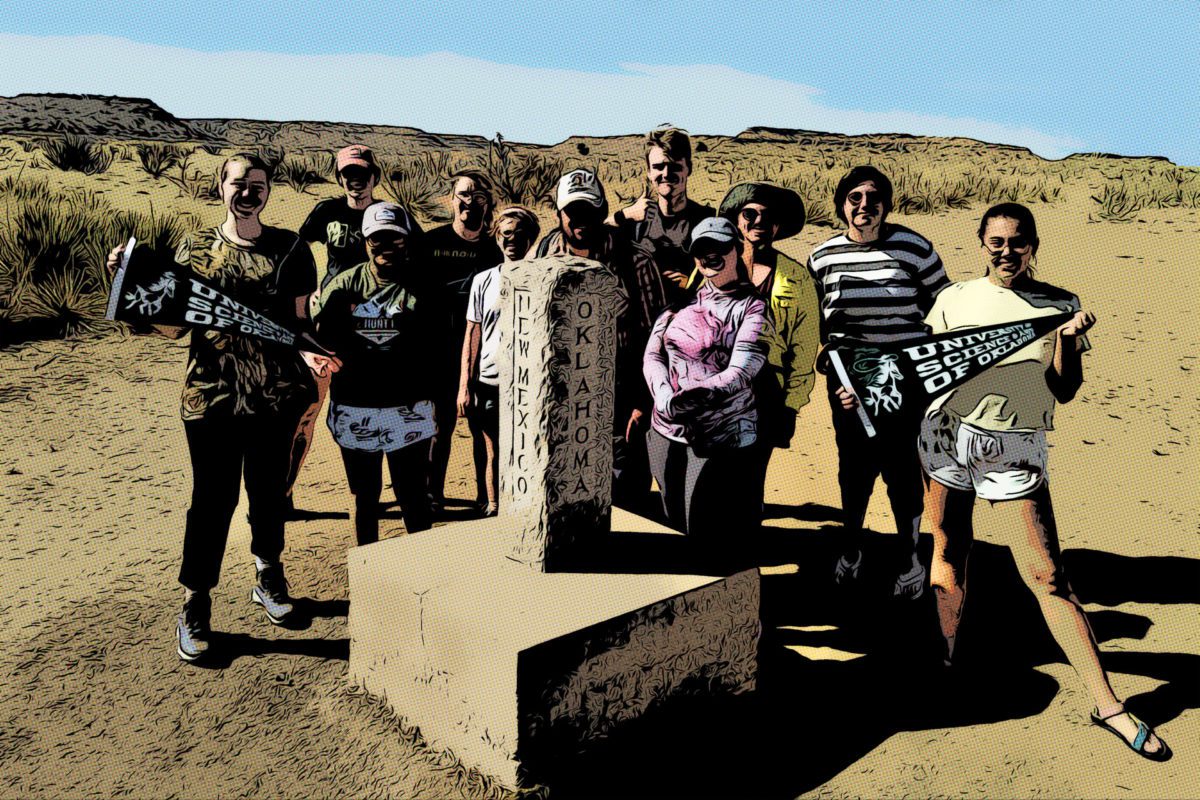Safety and Security
Safety in schools is an evergreen concern, and the first line of security is the campus police.
“Every university in Tulsa has its own police, security and forces, and we defer to them,” says Capt. Richard Meulenberg of the Tulsa Police Department. “We will respond to assist them, but they all have their own police force, including in Tulsa Public Schools. We don’t reroute unless [there are] exigent circumstances.”
At the University of Oklahoma, director of media relations Mackenzie Scheer says the school offers numerous resources for safety, including OU SafeWalk and SafeRIDE.
“The OU Police Department also routinely provides education, information and training to university community members regarding crime risks and prevention,” she says.
Tulsa Community College has been recognized by the American Association of Community Colleges in 2021 with the top award in the Leadership Safety and Planning category, says Nicole Burgin, the school’s media relations manager.
“TCC police officers participate in yearly training, and the policies and procedures followed by the TCC Police meet national accreditation standards,” says Melvin Murdock, TCC’s chief of police. “Our officers completed more than 2,600 hours of training in 2021, and we are well on pace to eclipse that number this year.”

Photo by Gary Lawson courtesy OSU
To augment this, the school has adopted programs such as the nationally endorsed “Run-Hide-Fight” paradigm, as well as digital tools including Rave Guardian and TCC Alerts, to help communicate during an emergency, says Burgin.
Oklahoma State University is “protected by a proactive campus police force of 35 officers with a 911 dispatch center on campus,” says OSU police chief Leon Jones. Pre-pandemic, he says, “the university offered multiple sessions of active shooter response training for the Stillwater campus. With COVID-19 restrictions lifting, sessions will be offered again in the fall and spring.”
At the OSU Center for Health Sciences, Melani Hamilton says leadership “encourages the use of Rave Guardian, an emergency messaging app, and utilizes a badge access system to maintain a strict protocol to access controlled areas.”
Nancy Hughes, associate vice president for Student Services and Human Resources at the University of Science and Arts of Oklahoma, says the school has “24/7 security on campus that patrol our buildings and grounds on a regular basis. Our emergency management plan addresses severe weather, fire and other emergency situations, and is shared annually with our faculty, staff and students.”
Campus and school safety are important topics with lots of moving parts, adds Mona Chamberlin with the University of Tulsa.
“Drills and information sessions about active shootings, campus threats and disaster response are keys in any successful risk-planning strategy. However, you cannot have a complete plan without preventative measures and considerations,” she says. “During the past two years … universities have witnessed a marked uptick in depression, anxiety and social withdrawal on campus. Demand for counseling services is at an all-time high. TU offers free counseling services to its students, a 24/7 on-call counselor, and a behavioral intervention team to address mental health concerns before they become individual or campus-wide safety concerns.”

Photo by Phil Shockley courtesy OSU
Technology Inside Classrooms: Pros and Cons
Technology has allowed teachers and students to reach beyond the classroom, says OSU’s Susan L. Stansberry, Ed.H., professor of learning, design and technology and principal investigator for NASA NSPACE.
“The tools available on the internet give teachers the opportunity to bring multiple perspectives into the classroom. It allows students to become producers of media-based content rather than just consumers,” she says. “One outcome we have seen since the pandemic forced emergency remote learning is teachers have become more thoughtful and purposeful with supporting learning through technology integration, rather than just using the technology for the bells and whistles.”
Hamilton says technology has made getting a degree substantially more accessible at OSU-CHS.
“The expansion of technology and distance learning allows us to be one campus in two locations with shared lectures and resources at our Tulsa and Tahlequah campuses,” she says. “Many of our graduate certificate programs and master’s degrees can be completed online.”
The pros of technology in the classroom include:
- Up-to-the-minute information
- Accommodation for a larger range of students
- The ability for more complex data sets and calculations to be taught and learned
- Less paper waste
- Easier collaboration
Cons:
- Further fact-checking/verification necessary due to so many new sources of data
- Potential for plagiarism/loss of academic integrity
- Automation decreasing the need for learning fundamentals
- More distractions

Resources for Money Management
Being money smart in addition to book-smart is key to overall college success.
“Science and Arts has sponsored money management programs, such as Oklahoma Money Matters, throughout the academic year,” says Hughes. “Topics have included College Life on a Budget, Student Loan Management, and Borrow Smart from the Start. We have resources on campus such as our Campus Co-Op where students can obtain food and other necessities at no cost.”
Hughes offers a few tips to help students save money at college:
- Rent or buy used textbooks
- Track your spending
- Look for opportunities to work on campus in order to save gas money
- Tap into the alumni office and other sources for scholarships
- Participate in events on campus;
there is often free food available
Understanding how to pay for college can be stressful, says Scheer. To help, OU’s MidFirst Bank MoneyCoach Program assists students and families in making a financial success plan – from understanding borrowing options to student loan repayment and budgeting. All first-year students are automatically assigned a MoneyCoach during the initial enrollment process. The MoneyCoach program also offers financial education workshops across campus.
Students are encouraged to enroll in OU’s “Nine Things Every College Student Should Know About Money” course. Designed to give students basic knowledge of personal finance and money management, the class covers topics such as saving, credit cards, investing, credit scores, buying a home and other monetary issues.

Photo courtesy Science and Arts
The Importance
of Soft Skills
Soft skills are integral to landing a job after college, and those dictating curriculum know this.
“At OU, many of these [soft] skills are taught as part of our general education curriculum,” says Sheer. “Engaging in different topics and with individuals from all walks of life can enhance a student’s soft skills and help prepare them for their careers.”
This is not a new issue or consideration in the higher education landscape; nonetheless, it has and will continue to be one of the most needed training focuses, says Chamberlin.
“From consent workshops to bystander intervention trainings, mediation during conflicts and individual mentorship, the work to help students understand how to disagree, express their internal experience and increase their overall emotional IQ is some of the most challenging and rewarding work on college campuses.”
Northeastern State University prides itself on being a premier immersive learning institution, says Shannon Schwaebler, the director of career services.
“This means we fully integrate students into the curriculum, allowing them to develop holistically while being a student at NSU. Students have the ability to learn and develop soft skills through in- and out-of-class experiences,” she says. “The crucial piece is to have intentional conversations around what consists of an experience worth highlighting to an employer, and what skills have been developed through said experience. We know soft skills are also referenced as transferable skills.”
OSU Center for Health Sciences was recently awarded the 2022 Albert Bandura Influencer Award from Crucial Learning, which is a learning company with courses in communication, performance and leadership.
“Named for Bandura – a world-renowned psychologist – the award recognizes organizations, leaders and scholars who have advanced both scholarship and practice in enabling self-directed human change,” says Hamilton. “OSU-CHS trained its faculty, students and residents in Crucial Learning’s Crucial Conversations course. In a formal analysis, after implementing Crucial Conversations, OSU faculty found improvements in the areas of teamwork climate, safety climate, job satisfaction, stress recognition, perceptions of management and working conditions.”

Photos courtesy TU
Staying on the Bright Side
The last few years have been tough for educators, no doubt about it.
“In the pandemic, those of us in education had to pivot to remote courses and virtual meetings – which lasted much longer than we initially thought it would – all while trying to take care of ourselves and our loved ones,” says NSU’s Carla Swearingen, Ph.D, the assistant vice principal of academic affairs. “One of the joys of the last year has been a slow return to normal. Though it has been a tough environment for all of us, what keeps us going is a focus on students.”
Like other educational organizations, TU has faced pandemic-related challenges.
“One consistent bright spot is our faculty and staff’s dedication to the institution and our students,” says Chamberlin. “We have worked diligently to provide generous holiday, vacation, sick and personal leave banks so that our employees could recharge and deal with family issues as well as care for themselves during this trying time. TU offers an employee assistance program for all faculty and staff as well as comprehensive health benefits to support the physical and emotional wellbeing of our employees and their families.”

A Lowered Attention Span
Attention spans have been decreasing for decades with the development of radio, television, advertising and now, social media, says Scheer.
“Faculty have been moving to engaged learning practice including active learning, in class participation and experiential learning,” she says. “Scaffolding learning has also been productive in creating shorter, specific assignments and shorter, 4 to 5 minute instructional videos instead of hour-long lecture videos.”
Chamberlin continues: “It’s true we have more channels of information and a higher degree of focus needed to stay attentive. However, when a student finds a compelling activity or interest, very rarely do they have a hard time attending or focusing on that activity. It’s only the challenging or somewhat less entertaining, attractive and immediately gratifying activities that students today struggle to stay on task within a regular pattern. The necessary skill development is delayed gratification and persistence.”
Parental Involvement: How Much is Too Much?
Having a support system is crucial to a student’s success in college, but they also need to learn to succeed on their own two feet.
“We understand that each student’s situation is different, and we understand that support comes from many sources,” says Hughes. “It’s important for support systems and families to be a part of this transition to adulthood and independence. They can offer support and guidance. We encourage families and their students to have realistic expectations of each other during this time and we also want to make sure that families and support systems know the resources that are available for their students so that they know where to direct them as needs arise.”
Support comes in many forms and doesn’t look the same for everyone, says Burgin.
“At TCC, the average student age is 24, so the college recognizes the need for support to come from multiple sources, which may include various friends and family of the students, faculty and staff, as well as other community members,” she says. “The college has intentionally developed and implemented student support and resources across the institution. This includes helping to reduce barriers from starting the college process. In creating the new Student Success Centers on the four main campuses, we provide our students an opportunity to start with an end in mind.”























